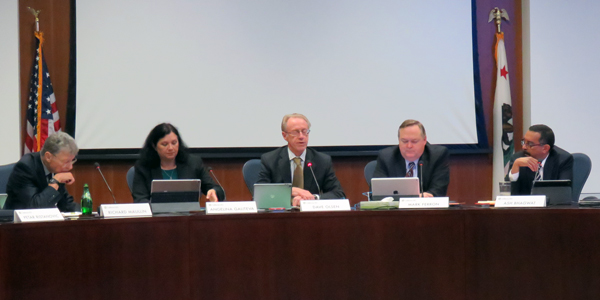By Jason Fordney
FOLSOM, Calif. — The CAISO Board of Governors on Thursday approved a controversial proposal on congestion revenue rights and market power mitigation, changes with major financial implications for its markets.
The changes are a result of the CAISO Department of Market Monitoring’s conclusion that the annual CRR auctions are costing retail electricity customers hundreds of millions of dollars by forcing them to be unwilling partners in losing transactions.
CAISO’s proposal limits CRR sources and sinks to only the combinations needed to hedge congestion costs associated with delivering supply. Auction participants can currently purchase CRRs at generator locations, load locations, trading hubs, pricing nodes, and import and export scheduling points.
Another change establishes a deadline to report transmission outages prior to the auctions to more accurately estimate transmission capacity available for CRR purchases.

Bhagwat | © RTO Insider
The CRR auctions have been highly profitable for financial interests, leading to heavy debate and questioning of CAISO’s logic. That debate continued Thursday, with the broadest consensus being that the board-approved changes, which will be submitted for FERC approval, only partially addressed the situation. The ISO says further alterations to the CRR process are in the pipeline.

Olsen | © RTO Insider
“This is a serious issue that has to be fixed,” Chairman David Olsen said as the board unanimously approved the proposal.
Governor Ashutosh Bhagwat said that without voluntary sellers, “it’s not a real market,” and he asked whether CRRs could be handled through bilateral transactions.
“These are not voluntary sellers,” he said of CRRs, “and it’s not working.”
There had been much discussion during development of the proposal over whether it would overly limit legitimate hedging activity. (See CAISO Urged to Take Slower CRR Approach.)

Berberich | © RTO Insider
During Thursday’s discussion, CAISO CEO Steve Berberich responded to the criticism by saying that CRRs are a valid market tool. But “this is a watershed moment for this organization to send a message … and that is, we agree the current situation has to change,” he said.
By the Monitor’s calculations, the CRR auction has had a $750 million deficiency for retail ratepayers, and annual deficiencies will grow in 2018 under the current structure. The Monitor did not support the changes and said the auction should be based on “willing buyers and sellers” and that more fundamental flaws should be addressed.
CAISO Approves Bidding Rule Changes
The board also approved CAISO’s Commitment Cost and Default Energy Bid Enhancements (CCDEBE), another contentious proposal that is opposed by some investor-owned utilities.
The proposal replaces a static commitment cost bid cap with a local market power mitigation test, which identifies whether a resource needs to be committed to relieve a transmission overload or other constraints. The ISO will only mitigate bids when a generator fails the test.

CAISO Board of Governors left to right: Richard Maullin, Angelina Galiteva, Dave Olsen, Mark Ferron, Ashutosh Bhagwat | © RTO Insider
The Energy Imbalance Market (EIM) Governing Body earlier this month gave advisory approval of the changes, subject to a condition that staff brief it and the CAISO board at the 12-month point following implementation of the changes. (See EIM Governing Body Approves CAISO Bidding Flexibility.) The ISO has been developing the proposal since last year to address what is said to be inadequate cost recovery for generators.
Under the current rules, bids are capped at the generator’s reference level, which is determined by multiplying costs — based on published natural gas price indices — by 125%.
CAISO recently adjusted the proposal by lowering the proposed multiplier for the first 18-month period after implementation to 150% from 200%. The ISO plans to phase in commitment cost bidding flexibility, first raising the commitment cost multiplier to 150% for the first 18 months, and then increasing it to 300% if no issues arise.
Pacific Gas and Electric wants CAISO to maintain the existing 125% cap, saying CCDEBE will have limited benefits. NRG Energy said the proposed caps are too low.
Board Approves Transmission Plan
The board on Thursday also approved the ISO’s 2017-2018 transmission plan, which cuts $2.7 billion from previously approved projects. The plan outlines the proposed design and construction of 17 new projects costing about $271 million. It recommends cancellation of 18 projects and revises 21 others in PG&E’s service area, and two in the San Diego Gas & Electric territory.
The main reasons for the reductions were changing load forecasts, energy efficiency improvements and increased residential rooftop solar systems. (See CAISO Recommends $2.7 Billion Tx Spending Cut.)
The approval will be used to launch the next planning phase, as it is plugged into the California Public Utilities Commission transmission procurement plan for utilities. The process will determine eligibility for incentive rate cost recovery from FERC by virtue of being part of a state plan.


